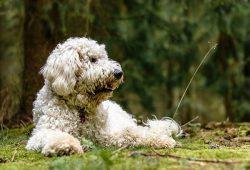The barbet is a breed of dog; it is a medium-sized French water dog. It is listed in Group 8 (retrievers, flushing dogs, water dogs) by the Société Centrale Canine, the French Kennel Club.
The breed name “barbet” comes from the French word barbe, which means beard.
Description
The barbet is a rare breed. Most barbets, especially those shown in conformation shows, are entirely black, black and white, or brown. It is common to see white chest spots and white paws or legs on black or brown coated dogs. Parti, creme, and pied variations are being born but in very limited numbers.
Male barbets usually grow to be about 21 to 25 in (53 to 64 cm) tall and between 40 and 60 lb (18 and 27 kg), while females usually reach about 20 to 23 in (51 to 58 cm) and 30 to 50 lb (14 to 23 kg).
Appearance
The breed stands 58–65 cm (23–26 in) for the males, 48.26–61 cm (19.00–24.02 in) for females with a tolerance of 1 cm +/- 1 cm (0.39 in), and weighs 17–28 kg (37–62 lb). The barbet is a prototypic water dog, with a long, woolly, and curly coat.
Their coats grow long and must be groomed regularly, otherwise the coat can become matted and the barbet may lose small tufts of hair like tumbleweeds.
The accepted colours of the breed are solid black, brown, fawn, grey, pale fawn, white, or more or less pied. All shades of red-fawn and pale fawn are permitted. The shade should, preferably, be the same as the colour of the body. Grey and white are extremely rare; mixed colours (except with white) are considered a fault. The most common colors are black or brown with white markings. The birth figures worldwide for 2007 are 176. All born were black or brown some with white markings on the chest, chin, and legs.
Temperament
The barbet’s personality is described as friendly, joyful, obedient, and intelligent. They are quick to learn and need lifelong obedience training. They are a great with children, families, and the elderly. Barbets will bond with their family and prefer to be in the same room with the family at all times. They need exercise daily to keep the dog in a healthy state of mind and body.
They are capable retrievers for waterfowl hunting. In France, the barbet can take the Test d’Aptitudes Naturelles (T.A.N.), a basic water retrieving test, and has recently been permitted to participate in the BCE (Brevet de Chasse a l’Eau), a general hunting test involving field and water trials. In Germany, the barbet takes part in field trials.
Overall Health
Due to the extremely low number of barbets in the world, little is known about long term health issues. Some issues that have exhibited themselves are ear infections, hip dysplasia, hernias, undescended testicles, undershot/overshot bites, and epilepsy. However, a study has just begun in France about health issues in the barbet as several breeds have recently “contributed” to the Barbet. Most breeders today hipscore the parents before any matings and A, B, and C hipscores can be used.
The most common of these issues are ear infections, a problem in most water dog varieties. Ear problems can be minimized by proper ear care. A veterinarian should be consulted if the dog shows signs of an ear infection. The ear should always be clear of any hair, and inspected very regularly.
Hip dysplasia
Like poodles, barbets are vulnerable to hip dysplasia. However, the risk of a barbet developing hip dysplasia can be greatly reduced by thoroughly checking the pedigrees and health clearances in both the sire and dam of your dog.
Lifespan
Lifespan of the barbet averages 13–15 years with one recorded living until 19 years of age.
Barbet (dog). (2017, February 6). In Wikipedia, The Free Encyclopedia. Retrieved from https://en.wikipedia.org/w/index.php?title=Barbet_(dog)&oldid=764050432


